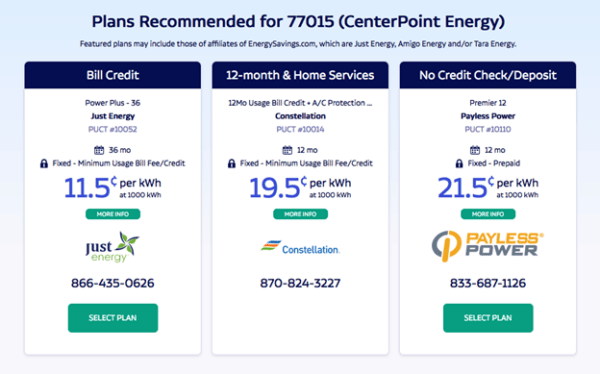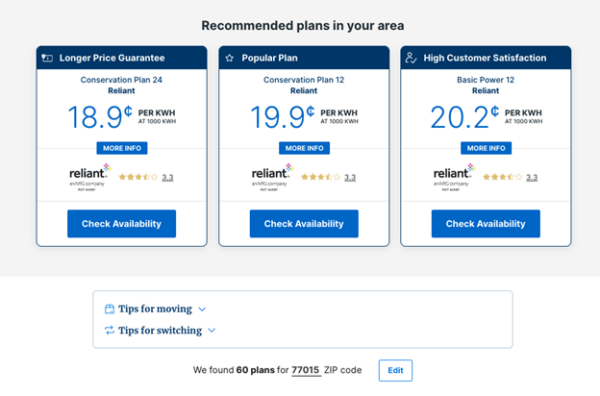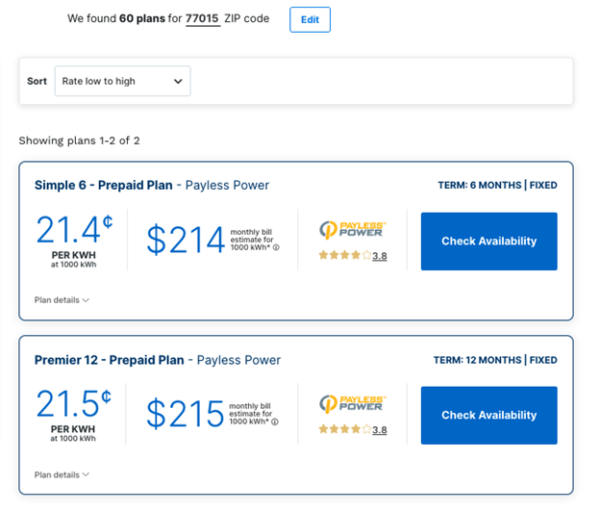
Texas’ deregulated energy market means around 85% of Lone Star State residents can switch energy suppliers. But searching online for energy providers to help save you money on energy bills produces an almost unnavigable number of results.
Among the energy companies are energy brokers, all promising to help reduce energy costs in a simple manner. Choosing who to trust is as tricky as finding the best offer.
At EnergySavings.com, we’re proud of our energy-efficiency information and energy-saving tips that help people use less energy. But we know it’s not all about energy conservation; people want to live their lives but know they’re getting low-cost electricity.
EnergySavings.com can also help people compare rates and plans across Texas with upfront and honest information. But how do we shape up against other energy websites? This article compares EnergySavings.com vs. SaveOnEnergy to help clear things up.
EnergySavings.com vs. SaveOnEnergy and the Power to Choose
EnergySavings.com and SaveOnEnergy overlap in several services, with information on energy consumption, renewable energy, and energy use.
EnergySavings.com
- Headquarters in Plano, Texas, as part of Interactive Energy Group
- Specializes in Texas-related energy news, efficiency measures, and energy plans
- Free service and independent information for users
- More than 20 years of experience in the Texas energy market
- Headquarters in Fort Mill, South Carolina
- Specializes in energy plans across many states
- Offers free service and independent information about energy deals
Compare Rates in Texas: Who Can Choose?
Around 85% of Texas residents live in deregulated energy market areas. More than 140 electric providers — known officially as retail electricity providers or REPs — compete for trade across the Lone Star State’s open energy market. Similarly, people compete to find the best electricity deals by comparing rates, often on price comparison websites.
The Public Utility Commission of Texas (PUC or PUCT) chooses a REP for anyone living in the state’s regulated energy zones. For example, most Austin residents receive their electricity supply from Austin Energy because this is a regulated area.
Power to Choose: EnergySavings.com vs. SaveOnEnergy
Energy deregulation is significant in Texas for those residents that can choose their energy supplier. The PUCT hosts a website that collates all official energy offers across the Lone Star State, called Power to Choose.
Understanding Power to Choose is key to switching suppliers or getting connected.
Both EnergySavings.com and SaveOnEnergy have guides on how to use Power to Choose. The difference is that EnergySavings.com has a portfolio of articles to peruse. People can learn more about Power to Choose and energy from EnergySavings.com compared to SaveOnEnergy.
Power to Choose isn’t the only way to compare rates; that’s why price comparison websites like EnergySavings.com and SaveOnEnergy exist. These companies provide an alternative way to compare prices, often reducing the number of offers on display but providing an easier-to-navigate search system.
Enter your ZIP Code and compare electricity rates
EnergySavings.com vs. SaveOnEnergy: How They Work
Both companies are energy brokers, working as intermediaries between energy companies and potential customers. They offer a tool for people to quickly search for and compare rates for electricity in Texas. Users enter their ZIP code to see a list of potential plans. EnergySavings.com covers Texas only, while SaveOnEnergy covers Texas and several other states. People using non-Texas ZIP codes will be redirected to SaveOnEnergy’s relevant sister website.
EnergySavings.com and the SaveOnEnergy websites explain how the companies make money as energy brokers. Neither charges browsing customers fees directly.
SaveOnEnergy and EnergySavings.com receive recompense from advertisers and energy providers. These companies may pay brokers when people click on links, call the company, apply for products, or submit information for quotes.
One main difference is that EnergySavings.com won’t ask for your personal information when you want to sign up for one of their offered deals.
Following a ZIP code search, EnergySavings.com highlights its best deals. Anyone clicking ‘Select Plan’ is directed to the energy company in question’s website. All dealings are direct with the chosen company, meaning customers aren’t dealing with an intermediary between clients and energy suppliers.
EnergySavings.com finds relevant offers and then shows you where to find them — but doesn’t sell or deal energy directly. The website also has a useful filter tool, giving people search flexibility similar to the Power to Choose website. Options include:
- With or without minimum usage levels
- Renewable energy options
- Deals with free time-of-use options like free electricity at weekends or evenings
- Contract length
- Fixed or variable rates
- Searching by energy provider
Similarly, SaveOnEnergy shows its own best deals. SaveOnEnergy can’t distribute or sell energy but can display rates. However, if you select a plan, you’ll need to give the SaveOnEnergy website more information before being redirected to a contract.
Filter options include if you are moving home or just switching providers, fixed or variable rates, contract length, customer ratings, energy provider, renewable energy elements, and if credit checks are required.
Comparison of Rates: EnergySavings.com vs. SaveOnEnergy
Each company operates as an energy comparison website as well as provides information to help reduce utility bills. Note that the results below can change without prior notice. Also keep in mind that energy customers need to contact either company for their energy rates.
We searched for ZIP code 77015 (Houston) on Nov. 8, 2022, for 1,000 kilowatt-hours (kWh) monthly usage to compare residential rates the companies could find. The most suitable option may only sometimes be the lowest price per kWh; however, this example illustrates differences in results.
EnergySavings.com found:
- Prices between 11.5 and 21.5 cents per kWh
- Contracts lasting 12-60 months
- Fixed-rate, minimum usage, and prepaid offers
- At least 15 different energy plans
SaveOnEnergy found:
- Prices between 18.9 and 21.5 cents per kWh (more expensive overall)
- Contracts lasting 6-24 months
- Fixed-rate offers
- A total of five energy plans, despite claiming to have found 60 offers
EnergySavings.com vs. SaveOnEnergy: Differences and Similarities
EnergySavings.com and SaveOnEnergy may look similar at first glance, but there are also significant differences.
Similarities: Both websites show and compare energy rates for Texas residents, publish energy and energy-efficiency advice, and explain Texas’ deregulated energy market. There are also sections about renewable energy. Visitors to either company can learn about switching electric companies in Texas and learn about the state’s utilities and some of its energy companies.
Both companies are energy brokers and generate income from advertisers, thanks to the people visiting their websites and showing interest in the displayed products.
Differences: EnergySavings.com’s unique selling points include a more in-depth and wider variety of Texas-related energy information, more search filter options with a greater ability to compare plans, and direct referrals, so people deal one-to-one with energy companies.
EnergySavings.com doesn’t ask for personal information from people. It also offers a newsletter to bring people news and its latest offers.
SaveOnEnergy has specialist information about solar panels and requests more information from potential clients. The company doesn’t just cover Texas. If someone puts in a non-Texas ZIP code, the SaveOnEnergy site sends them to a sister website.
EnergySavings.com vs. SaveOnEnergy: The Benefits
Here are the benefits when weighing EnergySavings.com vs. SaveOnEnergy as your price comparison tool.
EnergySavings.com benefits:
- Regularly updated and independently minded blog covering energy efficiency and energy saving
- Lots of information about Texas’ energy market: deregulation, utilities, and electric companies explained
- Texas energy market experts with more than 20 years of experience
- User-friendly filter options to help narrow searches when people compare plans
- Newsletter with information and offers
- Customer support is available by email
SaveOnEnergy benefits:
- Comprehensive information about solar panels and installation
- Intuitive search tool to compare plans
- Customer support and contact are available via email, phone, Twitter, and Facebook
- Almost 20 years of serving Texas and other states
- In-depth information about many Texas electric companies
EnergySavings.com vs. SaveOnEnergy: Educating Consumers
In addition to helping consumers compare energy plans, these two companies also provide educational materials for customers to better understand energy topics.
EnergySavings.com is a fantastic resource for anything energy-related. The company has an energy news section plus a detailed analysis of electricity prices across Texas. It publishes information on energy-related financial incentives, grants, and rebates, all the way to fixing air leaks with caulk.
A true strength for consumers who want to save energy is EnergySavings.com’s regularly updated blog. If you want to reduce the amount of energy you’re using, there are many in-depth articles, such as:
- How to use a programmable thermostat or smart thermostat to reduce energy consumption and save money
- Explaining energy-efficient appliances that carry the ENERGY STAR label, from washers to hot water heaters to power strips to air conditioners
- The lowdown on energy-efficient light bulbs, like LEDs vs. incandescent bulbs
To conserve energy to reduce utility bills, read about:
- Behavioral energy-efficiency changes such as using timers to run dishwashers with full loads at night or using ceiling fans instead of or alongside HVAC systems
More significant purchases homeowners may be considering, like heat pumps or new air conditioning, are also covered, as is safety, with advice on natural gas leaks. The blog even covers utilities and unbiased overviews of energy companies. There’s a newsletter covering energy news and offers, too.
SaveOnEnergy’s support literature covers similar energy-efficiency ground. Articles tend to be shorter, and there are fewer regular posts in its resources section. Some blogs cover nationwide topics, and some focus on Texas. The company has a large section on solar panels, covering everything from costs to installation and tips for solar panels for RVs and campers.
How to Contact EnergySavings.com and SaveOnEnergy
EnergySavings.com prides itself on presenting unbiased and open information to help people make decisions. It doesn’t take personal information or make money directly from customers, so it doesn’t require a large customer services section. Anyone that does wish to contact the support team can email support@energysavings.com.
The company also provides a page with utility contacts in case of outages, details for the Public Utility Commission of Texas (PUCT), and several electric companies.
SaveOnEnergy has a customer service email, Facebook, Twitter, and a phone number to call. It also lists PUCT contact details. Its customer service section is on-hand to answer any queries people may have about its services.
EnergySavings.com vs. SaveOnEnergy: Final Points
The best advice is to use as many comparison websites as possible when looking to switch, including PUCT’s Power to Choose. Compare the plans offered and the added value that each website offers.
EnergySavings.com lags ever so slightly in its website’s user-friendliness compared to SaveOnEnergy, but that betrays its helpfulness. There’s a wide range of practical and helpful information to assist with price comparison searches. Visitors can answer almost all of their Texas energy questions using EnergySavings.com’s resources.
SaveOnEnergy and its related companies offer energy deals across more than just Texas, making it more useful for non-Texans. Another strong point is its renewable energy focus. People interested in solar panels and products can find a swathe of solar-related advice and information.
Both companies have excellent search tools with varying results. EnergySavings.com adds the transparent nature of sending interested parties directly to energy companies.
EnergySavings.com shows its colors in the company name: Save money and energy by following the recommended efficiency improvements. Ideally, use EnergySavings.com’s price comparison tool to find an energy deal more suited to your lifestyle to pair with this newfound energy efficiency.
There’s also the bonus of reducing your emissions to help the whole world breathe more easily. You can choose electricity from renewable energy sources like solar or wind rather than fossil fuel power plants like coal and natural gas.
Always read every offer’s Electricity Facts Label (EFL) before signing anything, so you understand all the terms and conditions. And whatever you do, ask yourself these questions before switching suppliers.






